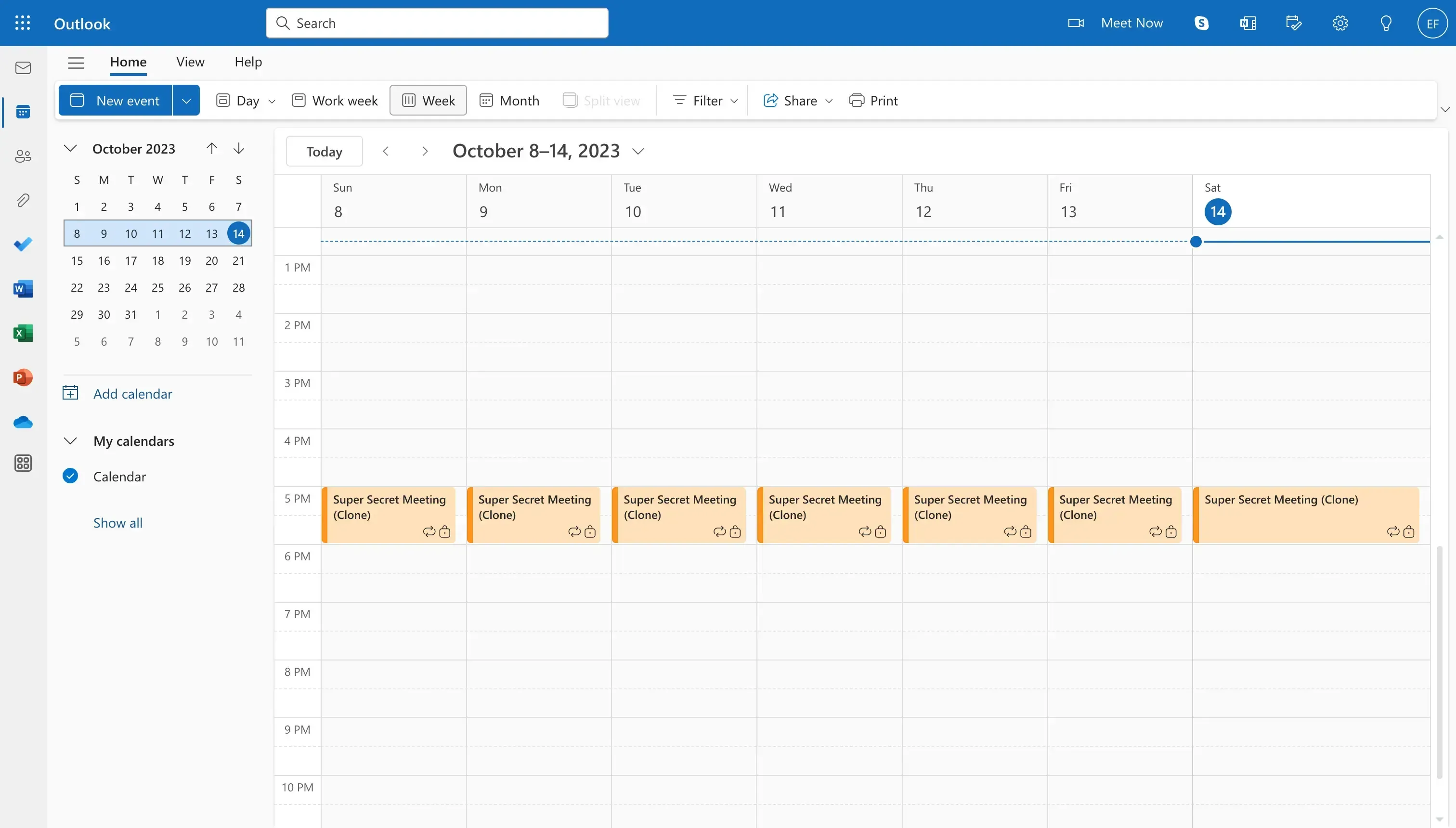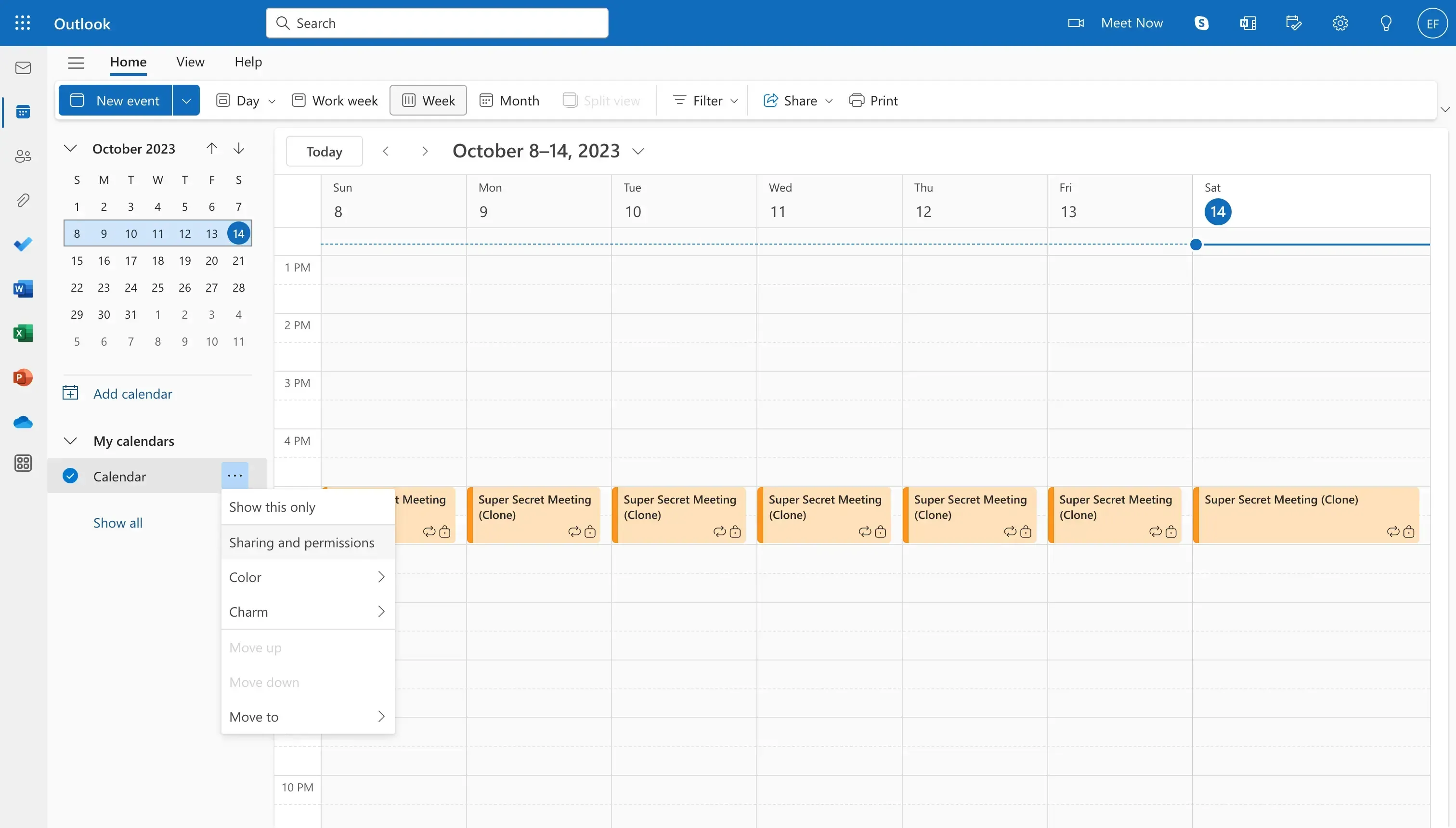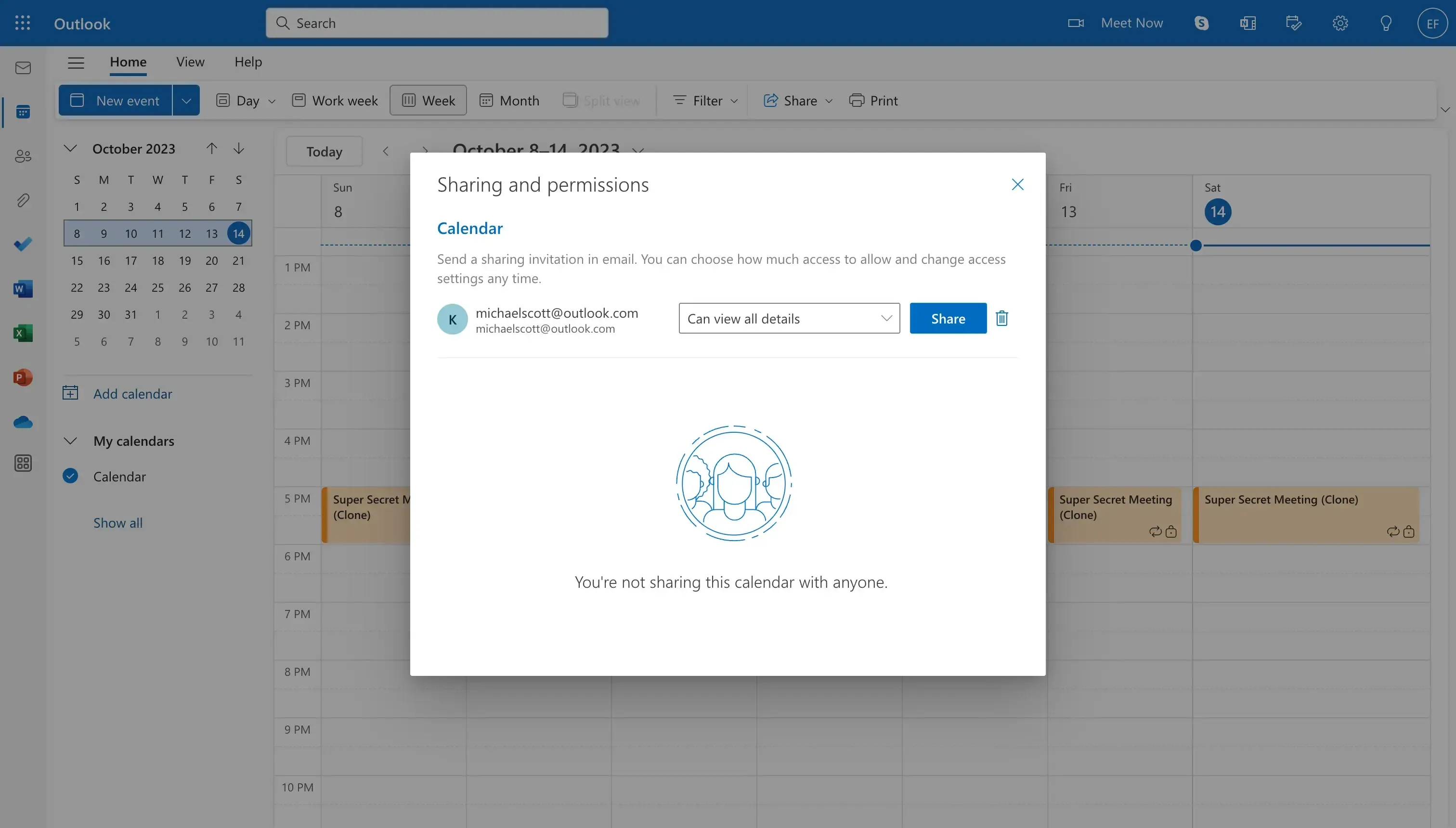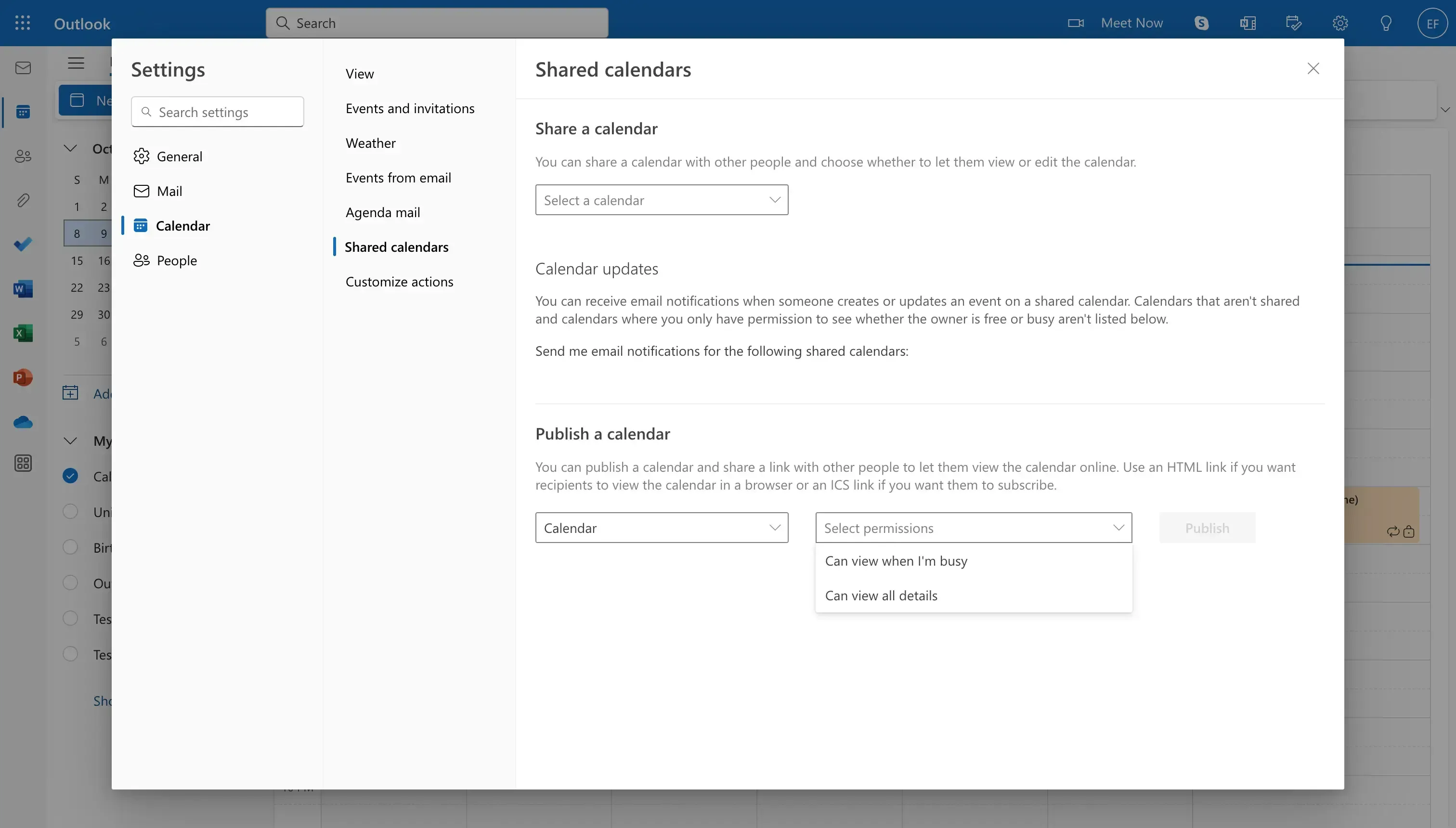How to Share Outlook Calendar - The Ultimate Guide
Table of Contents
Ready to Sync Your Calendars?
Create a OneCal account to sync multiple Outlook, iCloud and Google Calendars, create Booking Links, and much more.
Microsoft Outlook is one of the most powerful digital calendars, used by large corporations, small businesses, individuals, students, and more. Often, Outlook users also have other calendars, such as Google Calendar, or Apple Calendar, or have specific sharing needs, such as sharing their Outlook Calendar with other people.
In this article, we’ll explore how to share Outlook Calendar to an Outlook Calendar, Google Calendar, with specific people, or by an URL. We’ll also explore the downsides of sharing Outlook Calendars, along with some privacy concerns and best practices.
If you are a Google Calendar user, please read the detailed guide we wrote on How to Share Google Calendar.
What are Shared Outlook Calendars and how do they work?
Given that Outlook is one of the most used Calendars, it has added features to make collaboration between individuals, teams, or organizations easier. One of those features is the ability to have shared Outlook Calendars with other people, and for other people to share Calendars with you. The same principle applies to groups or organizations.
When you import a calendar into Outlook, you can choose to import it as a shared calendar. This will allow the person who shared the calendar with you to make changes to the calendar, and you will see those changes in your Outlook calendar.
The downfalls of sharing Outlook Calendars
Even though shared Outlook Calendars are useful, they have a few restrictions:
You cannot make changes to a shared calendar unless you have permission to do so. The person who shared the calendar with you can control what permissions you have. For example, they can allow you to view the calendar, edit the calendar, or even delete the calendar.
Shared calendars may not be synchronized with Outlook in real-time. If the person who shared the calendar with you makes changes to the calendar, it may take some time for those changes to appear in your Outlook calendar. For example, if you share a Google Calendar with Outlook, new events might take up to 24 hours to update.
The Find a Time feature may not check the slots in shared calendars. If a co-worker uses the Find a Time feature in Outlook, they won’t be able to see the busy slots in your shared calendars. This might lead to scheduling conflicts and confusion between team members.
This is a known limitation of the Find a Time feature, and Microsoft is working to improve it in future versions of Outlook.
Overall, shared Outlook calendars are a great way to collaborate with other people and stay organized. However, it is important to be aware of the restrictions that apply to shared calendars.
How to Share an Outlook Calendar with specific people? Which calendar-sharing privacy controls are safer to use?
One of the most common ways of sharing Outlook Calendar is to share it with specific people, such as your family, co-workers, etc.
To share an Outlook Calendar with specific people, please follow these steps:
Open Outlook and go to the Calendar view.

Right-click on the calendar that you want to share and select Sharing and Permissions.

In the Share Calendar dialog box, click Enter an Email address or contact name.

Type in the email addresses of the people that you want to share the calendar with, or enter their contact if you’ve interacted with them before. After that, click OK.

Select the level of permissions that you want to give to the people that you are sharing the calendar with. You can choose to give them permission to view the calendar and edit the calendar.
Click Share to send the sharing invitation.
We always recommend sharing the Outlook Calendar with caution, using the least amount of permissions. Usually, just permitting to view the calendar is sufficient.
How to share an Outlook Calendar using a URL
Microsoft Outlook has made it quite easy to import other calendars using a URL. This method works with Google Calendar, Outlook Calendar, Apple Calendars, etc. To share an Outlook Calendar using a URL, follow these steps:
Open Outlook and go to the Calendar view.

On the left side of the panel, click Add Calendar.
On the Add Calendar modal, click the Subscribe from the web tab.
Paste the ICS URL that you’ve copied from the other calendar.
Click Import
Your calendar is imported to your Outlook Calendar. Note that newly created events might take a while to propagate depending on the provider. For example, if you're sharing a Google Calendar, changes usually take up to 24 hours to propagate.
If automatic, real-time calendar updates are important to you, then you need a Calendar Sync Tool that helps you automatically sync your calendars.
How to share an Outlook Calendar with an Apple Calendar
Apple Calendar users can share their Calendar with Outlook, by creating a public URL inside Apple Calendar.
Open Apple Calendar
In the left sidebar, hover over the Apple Calendar you want to share and click the share option.
Tick the checkbox next to Public Calendar to generate a calendar URL.
Copy the Public Calendar URL
Open Outlook and go to the Calendar view.
On the left side of the panel, click Add Calendar.
On the Add Calendar modal, click the Subscribe from the web tab.
Paste the ICS URL that you’ve copied from the Apple Calendar.
Your Apple Calendar is shared with your Outlook Calendar
Note: This makes your Apple Calendar public. Please be cautious not to share the URL with anyone, as they’ll be able to see your meeting details.
Same as sharing Outlook with Google Calendar, upon the initial sharing, event updates might take a couple of hours to propagate.
How do you set permissions when sharing your Outlook Calendar? Which permissions are recommended? (important read to protect your privacy)
It’s very important to know the basic permissions you grant when sharing Outlook Calendars, as granting more permission than needed can make your Outlook Calendar fully accessible and editable by other people. This is very crucial for calendars that have sensitive meeting information, so please share with caution.
When sharing your Outlook Calendar with specific people, you can choose from these sharing permissions:
Can view all the details: This option only grants read-only access to people you’re sharing this calendar with, and it’s recommended to select this option when sharing your Outlook Calendar with specific people.
Can edit: This option is not recommended, as it grants write permissions to the people you’re sharing the Outlook Calendar. If you’ve got a specific use case that needs other people to edit your shared Calendar, then proceed with granting this permission, but generally, read-only access should be sufficient for most cases.
When publishing your Outlook Calendar to import it into another Outlook Calendar, you can choose from these sharing permissions:
Can view when I’m busy: This option allows other people to only view the slots when you’re busy in the Outlook Calendar you’re sharing but hides all event details. This is the recommended option to select, as it keeps all private information unexposed.
Can view all details: Not recommended, as it allows other users to view all your meetings, along with their descriptions, participants, and all private details. Please don’t select this option unless it’s needed for other people to view your private event details.

Can your IT administrator see your shared Outlook Calendar?
Unfortunately, yes. By default, IT administrators have full access to all user accounts in the organization, including their calendars. Knowing this, please share Outlook Calendars with caution.
Does sharing an Outlook Calendar block the time? Will I get double-booked?
Sharing an Outlook Calendar won’t block your time. If a co-worker uses the Find a Time feature in Outlook, they won’t be able to see the busy slots on your shared Outlook Calendars. This leads to scheduling conflicts and wasted time going back and forth to find new times to meet.
If you want to avoid these downsides, consider using a Calendar Automation Tool that keeps your privacy intact, actually blocks time, and avoids meeting conflicts.
Share your Outlook Calendars using OneCal
The methods we explained until now, work, but come with great downsides, such as privacy concerns, delayed meeting updates, etc. The best way to share your Outlook Calendar is by using OneCal.
Using OneCal, you can automatically block events on your primary Outlook Calendar, from any synced calendars.
Why should I use OneCal to share my Outlook Calendars?
OneCal bypasses all the downfalls of sharing Outlook Calendars:
Admins can’t see the meeting details: One of the main concerns on sharing Outlook Calendars is that admins can see the private details of the calendars you’re sharing. Using OneCal, you can select which properties of the events you want to share. You can mark all your events as ‘Busy’, and only sync the placeholder title. This means that your IT admins won’t be able to see your private events or the calendars you’ve shared.
Automatic, Real-time updates: The second benefit is that the event updates happen in real-time. When you create a meeting on the shared calendars, it will be reflected on theOutlook Calendar in real-time.
Actually blocks time, and avoids meeting conflicts: OneCal doesn’t create a shared calendar, instead sends events to your primary Outlook Calendar, which means that if co-workers use the Find a Time feature, they’ll be able to see your busy slots across all shared calendars.
You can sign up for a 14-day free trial, with no credit card required, to try sync your calendars using OneCal. Avoid meeting conflicts, and privacy concerns, save time, and focus on what matters.
FAQ
Does sharing an Outlook calendar block my time and prevent double-booking?
No. Outlook’s “Find a Time” only checks your primary calendar, so events on shared calendars can still be double-booked.
Can my IT administrator see my shared Outlook calendars?
Yes. In Microsoft 365, your admins can open any user’s calendars, including ones you’ve shared.
What’s the simplest way to keep Outlook, Google, and Apple calendars in sync without making any calendar public?
Use a calendar sync tool like OneCal to sync through each provider’s secure API. Nothing is exposed as a public link, and updates are real-time.
Does OneCal support two-way syncing between Outlook and Google?
Yes. OneCal can sync changes in both directions, keep busy blocks aligned, and allows you to choose what to sync between calendars, keeping your privacy intact.